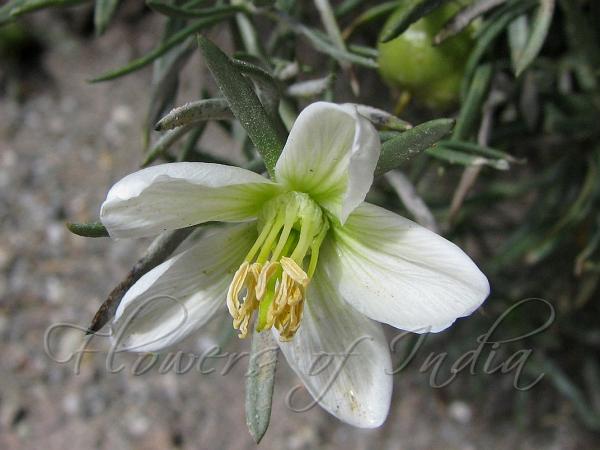|
| Harmal |
|

|

| File size | 127645 |
| Original date | 9/15/11 1:24 PM |
| Resolution | 1072 x 804 |
| Flash | Flash did not fire, auto |
| Focal length | 6.0mm |
| Exposure time | 1/640s |
| Aperture | 4.0 |
| Focus Distance | |
| Metering Mode | Center weighted average |
| Camera make | Canon |
| Camera model | Canon PowerShot S5 IS |
| Sensor type | OneChipColorArea |
|
|
|
|
Photo: |
Botanical name: Peganum harmala Family: Zygophyllaceae (Caltrop family)
Synonyms: Peganum dauricum
Synonyms: Peganum dauricum
Harmal is a perennial plant which can grow to about 2.5 ft tall, but
normally it is about 1 ft tall. The roots of the plant can reach a depth
of up to 6.1 m, if the soil it is growing in is very dry. Leaves are
stalkless, 4-8 cm long, irregularly and pinnately cut into 3-5 cm long,
2-5 mm broad, linear-lanceshaped or subelliptic, pointed segments. The
flowers are yellowish-white and are about 2.5–3.8 cm in diameter. Petals
are obovate-oblong, 1.5-2 cm long, 6-9 mm wide. The round seed capsules
measure about 1–1.5 cm in diameter, have three chambers and carry more
than 50 seeds. A red dye, "Turkey Red," from the seeds is often used in
Western Asia to dye carpets. It is also used to dye wool. When the seeds
are extracted with water, a yellow fluorescent dye is obtained. If they
are extracted with alcohol, a red dye is obtained. The stems, roots and
seeds can be used to make inks, stains and tattoos. Harmal is found in the
Himalayas, from Afghanistan to Kashmir, and also in C. and W. Asia,
Europe and N. Africa. It is prominent in Ladakh and Kashmir valley,
at altitudes of 300-2400 m. Flowering: April-October.
Medicinal uses: Harmal is used as an analgesic and
anti-inflammatory agent. In Yemen it was used to treat depression, and it
has been established in the laboratory that harmaline, an active
ingredient in Peganum harmala, is a central nervous system stimulant and a
"reversible inhibitor of MAO-A (RIMA)," a category of antidepressant.
Harmal is used as an analgesic and
anti-inflammatory agent. In Yemen it was used to treat depression, and it
has been established in the laboratory that harmaline, an active
ingredient in Peganum harmala, is a central nervous system stimulant and a
"reversible inhibitor of MAO-A (RIMA)," a category of antidepressant.
Medicinal uses:
 Harmal is used as an analgesic and
anti-inflammatory agent. In Yemen it was used to treat depression, and it
has been established in the laboratory that harmaline, an active
ingredient in Peganum harmala, is a central nervous system stimulant and a
"reversible inhibitor of MAO-A (RIMA)," a category of antidepressant.
Harmal is used as an analgesic and
anti-inflammatory agent. In Yemen it was used to treat depression, and it
has been established in the laboratory that harmaline, an active
ingredient in Peganum harmala, is a central nervous system stimulant and a
"reversible inhibitor of MAO-A (RIMA)," a category of antidepressant. | Identification credit: Gurcharan Singh | Photographed in Ladakh. |
• Is this flower misidentified? If yes,